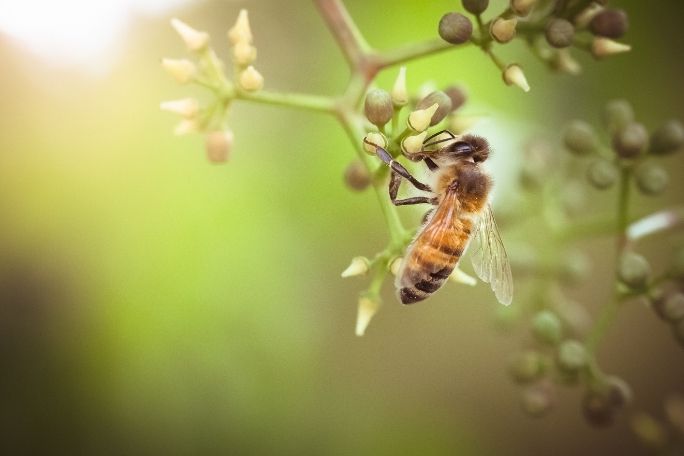Lesson summary
Bees pollinate at least a third of everything we eat and play a vital role in sustaining our ecosystems, therefore they need to be valued and protected. This lesson uses the jigsaw classroom method to facilitate student inquiry into the threats faced by bees. Students become experts in one threat faced by bees by reading information, then work with their group to make sense of what they have read. They present what they have learned to their peers. Students will apply their new understanding to create an Effects Wheel to explore the flow-on effects of threats to bee populations.
Essential questions:
- What are the threats to bees?
- What are the consequences of those threats?
- How do humans support bees?
- How do bees impact upon Planet, People and Profit?
Lesson guides and printables
Lesson details
Curriculum mapping
Australian curriculum content descriptions:
Year 5 English:
- Clarify understanding of content as it unfolds in formal and informal situations, connecting ideas to students’ own experiences and present and justify a point of view (ACELY1699)
- Use interaction skills, for example paraphrasing, questioning and interpreting non-verbal cues and choose vocabulary and vocal effects appropriate for different audiences and purposes (ACELY1796)
- Navigate and read texts for specific purposes applying appropriate text processing strategies, for example predicting and confirming, monitoring meaning, skimming and scanning (ACELY1702)
- Use comprehension strategies to analyse information, integrating and linking ideas from a variety of print and digital sources (ACELY1703)
Year 5 HASS – Economics and business:
- Types of resources (natural, human, capital) and the ways societies use them to satisfy the needs and wants of present and future generations (ACHASSK120)
- Influences on consumer choices and methods that can be used to help make informed personal consumer and financial choices (ACHASSK121)
Year 5 Science:
- Living things have structural features and adaptations that help them to survive in their environment (ACSSU043)
Year 6 English:
- Participate in and contribute to discussions, clarifying and interrogating ideas, developing and supporting arguments, sharing and evaluating information, experiences and opinions (ACELY1709)
- Use interaction skills, varying conventions of spoken interactions such as voice volume, tone, pitch and pace, according to group size, formality of interaction and needs and expertise of the audience (ACELY1816)
- Select, navigate and read texts for a range of purposes, applying appropriate text processing strategies and interpreting structural features, for example table of contents, glossary, chapters, headings and subheadings (ACELY1712)
- Use comprehension strategies to interpret and analyse information and ideas, comparing content from a variety of textual sources including media and digital texts (ACELY1713)
Year 6 HASS – Economics and business:
- The effect that consumer and financial decisions can have on the individual, the broader community and the environment (ACHASSK150)
Year 6 Science:
- The growth and survival of living things are affected by physical conditions of their environment (ACSSU094)
General capabilities: Ethical Understanding, Personal and Social Capability
Cross-curriculum priority: Sustainability OI.1, OI.3.
Relevant parts of Year 5 English achievement standards: When reading, students encounter and decode unfamiliar words using phonic, grammatical, semantic and contextual knowledge. Students use language features to show how ideas can be extended. They develop and explain a point of view about a text, selecting information, ideas and images from a range of resources.
Relevant parts of Year 5 HASS achievement standards: They describe factors that influence their choices as consumers and identify strategies that can be used to inform these choices.
Relevant parts of Year 5 Science achievement standards: They analyse how the form of living things enables them to function in their environments.
Relevant parts of Year 6 English achievement standards: Students compare and analyse information in different and complex texts, explaining literal and implied meaning. They select and use evidence from a text to explain their response to it. They listen to discussions, clarifying content and challenging others’ ideas. Students create detailed texts elaborating on key ideas for a range of purposes and audiences. They make presentations and contribute actively to class and group discussions, using a variety of strategies for effect.
Relevant parts of Year 6 HASS achievement standards: They describe the rights and responsibilities of Australian citizens and the obligations they may have as global citizens. Students recognise why choices about the allocation of resources involve trade-offs.
Relevant parts of Year 6 Science achievement standards: They describe and predict the effect of environmental changes on individual living things.
Unit of work: Love Food? Love Bees!
Time required: 120 mins.
Level of teacher scaffolding: Medium – facilitate class discussion.
Resources required
- Student Worksheet – one copy per student OR computers/tablets to access the online worksheet
- With Bees vs Without Bees pictures, projector, Bees Under Threat Factsheet set (print enough copies so that groups of four will all have one set), Effects Wheel Template (print one per student), Hive of Reflection print-out
- Butcher’s paper, textas, pencils and highlighters (optional)
Skills
This lesson is designed to build students’ competencies in the following skills:
- Critical thinking
- Creativity
- Collaboration
- Communication
- Ethical understanding
- Social skills
- Leadership
Additional info
This lesson has been created in partnership with ACT for Bees. ACT for Bees is a not-for-profit organisation taking action to preserve these essential pollinators, ensuring a food-secure future.


Welcome back!
Don't have an account yet?
Log in with:
By signing up to Cool.org you consent and agree to Cool's privacy policy to
store, manage and process your personal information. To read more, please see
our privacy policy here(Opens in new tab).
Create your free Cool.org account.
Many of our resources are free, with an option to upgrade to Cool+ for premium content.
Already have an account?
Sign up with:
By signing up to Cool.org you consent and agree to Cool's privacy policy to
store, manage and process your personal information. To read more, please see
our privacy policy here(Opens in new tab).